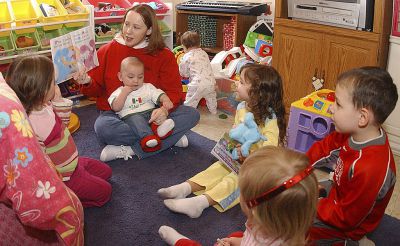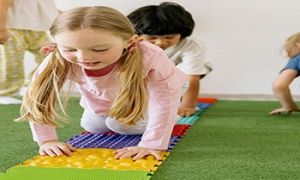To support children achieve learning outcomes from the EYLF Framework, the following list gives educators examples of how to promote children's learning in each individual learning outcome. These can be used when assessing children's learning, critically reflecting on the experiences planned, strategies to implement for each learning outcome and more. It also encourages and promotes each individual outcome throughout the early childhood setting.
Learning Outcome 1 - Children have a strong sense of identity
1.1 Children feel safe, secure, and supported
Educators promote this learning by:
- acknowledge and respond sensitively to children’s cues and signals.
- respond sensitively to children’s attempts to initiate interactions and conversations.
- support children’s secure attachment through consistent and warm nurturing relationships.
- support children in times of change and bridge the gap between the familiar and the unfamiliar.
- build upon culturally valued child rearing practices and approaches to learning.
- are emotionally available and support children’s expression of their thoughts and feelings.
- recognize that feelings of distress, fear or discomfort may take some time to resolve.
- acknowledge each child’s uniqueness in positive ways.
- spend time interacting and conversing with each child.
1.2 Children develop their emerging autonomy, inter-dependence, resilience and sense of agency
Educators promote this learning by:
- provide children with strategies to make informed choices about their behaviours.
- promote children’s sense of belonging, connectedness and wellbeing.
- maintain high expectations of each child’s capabilities.
- mediate and assist children to negotiate their rights in relation to the rights of others.
- provide opportunities for children to engage independently with tasks and play.
- display delight, encouragement and enthusiasm for children’s attempts.
- support children’s efforts, assisting and encouraging as appropriate.
- motivate and encourage children to succeed when they are faced with challenges.
- provide time and space for children to engage in both individual and collaborative pursuits.
- build on the culturally valued learning of individual children’s communities.
- encourage children to make choices and decisions.
1.3 Children develop knowledgeable and confident self identities
Educators promote this learning by:
- promote in all children a strong sense of who they are and their connectedness to others – a shared identity as Australians.
- ensure all children experience pride and confidence in their achievements.
- share children’s successes with families.
- show respect for diversity, acknowledging the varying approaches of children, families, communities and cultures.
- acknowledge and understand that children construct meaning in many different ways.
- demonstrate deep understanding of each child, their family and community contexts in planning for children’s learning.
- provide children with examples of the many ways identities and culture are recognized and expressed.
- build upon culturally valued approaches to learning.
- build on the knowledge, languages and understandings that children bring.
- talk with children in respectful ways about similarities and differences in people.
- provide rich and diverse resources that reflect children’s social worlds.
- listen to and learn about children’s understandings of themselves.
- actively support the maintenance of home language and culture.
- develop authentic children’s understanding of themselves.
1.4 Children learn to interact in relation to others with care, empathy and respect
Educators promote this learning by:
- initiate one-to-one interactions with children, particularly babies and toddlers, during daily routines.
- organize learning environments in ways that promote small group interactions and play experiences.
- model care, empathy and respect for children, staff and families.
- model explicit communication strategies to support children to initiate interactions and join in play and social experiences in ways that sustain productive relationships with other children.
- acknowledge children’s complex relationships and sensitively intervene in ways that promote consideration of alternative perspectives and social inclusion.
Learning Outcome 2: Children are connected with and contribute to their world
2.1 Children develop a sense of belonging to groups and communities and an understanding of the reciprocal rights and responsibilities necessary for active community participation
Educators promote this learning by:
- promote a sense of community within the early childhood setting.
- build connections between the early childhood setting and the local community.
- provide opportunities for children to investigate ideas, complex concepts and ethical issues that are relevant to their lives and their local communities.
- model language that children can use to express ideas, negotiate roles and collaborate to achieve goals.
- ensure that children have the skills to participate and contribute to group play and projects.
- plan opportunities for children to participate in meaningful ways in group discussions and shared decision-making about rules and expectations.
2.2 Children respond to diversity with respect
Educators promote this learning by:
- reflect on their own responses to diversity.
- plan experiences and provide resources that broaden children’s perspectives and encourage appreciation of diversity.
- expose children to different languages and dialects and encourage appreciation of linguistic diversity.
- encourage children to listen to others and to respect diverse perspectives.
- demonstrate positive responses to diversity in their own behaviour and in conversations with children.
- engage in interactions with children that promote respect for diversity and value distinctiveness.
- explore the culture, heritage, backgrounds and traditions of each child within the context of their community.
- explore with children their ideas about diversity.
2.3 Children become aware of fairness
Educators promote this learning by:
- notice and listen carefully to children’s concerns and discuss diverse perspectives on issues of inclusion and exclusion and fair and unfair behavior.
- engage children in discussions about respectful and equal relations such as when a child dominates in the use of resources.
- analyze and discuss with children ways in which texts construct a limited range of identities and reinforce stereotypes.
- draw children’s attention to issues of fairness relevant to them in the early childhood setting and community
2.4 Children become socially responsible and show respect for the environment
Educators promote this learning by:
- provide children with access to a range of natural materials in their environment.
- model respect, care and appreciation for the natural environment.
- find ways of enabling children to care for and learn from the land.
- consider the nature of children’s connectedness to the land and demonstrate respect for community protocols.
- share information and provide children with access to resources about the environment and the impact of human activities on environments.
- embed sustainability in daily routines and practices.
- look for examples of interdependence in the environment and discuss the ways the life and health of living things are interconnected.
Learning Outcome 3: Children have a strong sense of wellbeing
3.1 Children become strong in their social and emotional wellbeing
Educators promote this learning by:
- show genuine affection, understanding and respect for all children.
- collaborate with children to document their achievements and share their successes with their families.
- ensure that all children experience pride in their attempts and achievements.
- promote children’s sense of belonging, connectedness and wellbeing.
- challenge and support children to engage in and persevere at tasks and play.
- build upon and extend children’s ideas.
- maintain high expectations of each child’s capabilities.
- value children’s personal decision-making.
- welcome children and families sharing aspects of their culture and spiritual lives.
- talk with children about their emotions and responses to events with a view to supporting their understandings of emotional regulation and self-control.
- acknowledge and affirm children’s effort and growth.
- mediate and assist children to negotiate their rights in relation to the rights of others.
3.2 Children take increasing responsibility for their own health and physical wellbeing
Educators promote this learning by:
- plan for and participate in energetic physical activity with children, including dance, drama, movement and games.
- draw on family and community experiences and expertise to include familiar games and physical activities in play.
- provide a wide range of tools and materials to resource children’s fi ne and gross motor skills.
- actively support children to learn hygiene practices.
- promote continuity of children’s personal health and hygiene by sharing ownership of routines and schedules with children, families and the community.
- discuss health and safety issues with children and involve them in developing guidelines to keep the environment safe for all.
- engage children in experiences, conversations and routines that promote healthy lifestyles and good nutrition.
- consider the pace of the day within the context of the community.
- model and reinforce health, nutrition and personal hygiene practices with children.
- provide a range of active and restful experiences throughout the day and support children to make appropriate decisions regarding participation.
Learning Outcome 4: Children are confident and involved learners
4.1 Children develop dispositions for learning such as curiosity, cooperation, confidence, creativity, commitment, enthusiasm, persistence, imagination and reflexivity
Educators promote this learning by:
- recognize and value children’s involvement in learning.
- provide learning environments that are flexible and open-ended.
- respond to children’s displays of learning dispositions by commenting on them and providing encouragement and additional ideas.
- encourage children to engage in both individual and collaborative explorative learning processes.
- listen carefully to children’s ideas and discuss with them how these ideas might be developed.
- provide opportunities for children to revisit their ideas and extend their thinking.
- model inquiry processes, including wonder, curiosity and imagination, try new ideas and take on challenges.
- reflect with children on what and how they have learned.
4.2 Children develop a range of skills and processes such as problem solving, inquiry, experimentation, hypothesising, researching and investigating
Educators promote this learning by:
- plan learning environments with appropriate levels of challenge where children are encouraged to explore, experiment and take appropriate risks in their learning.
- recognize mathematical understandings that children bring to learning and build on these in ways that are relevant to each Child.
- provide babies and toddlers with resources that offer challenge, intrigue and surprise, support their investigations and share their enjoyment.
- provide experiences that encourage children to investigate and solve problems.
- encourage children to use language to describe and explain their ideas.
- provide opportunities for involvement in experiences that support the investigation of ideas, complex concepts and thinking, reasoning and hypothesising.
- encourage children to make their ideas and theories visible to others.
- model mathematical and scientific language and language associated with the arts.
- join in children’s play and model reasoning, predicting and reflecting processes and language.
- intentionally scaffold children’s understandings.
- listen carefully to children’s attempts to hypothesize and expand on their thinking through conversation and questioning.
4.3 Children transfer and adapt what they have learned from one context to another
Educators promote this learning by:
- value signs of children applying their learning in new ways and talk about this with them in ways that grow their understanding.
- support children to construct multiple solutions to problems and use different ways of thinking.
- draw children’s attention to patterns and relationships in the environment and in their learning.
- plan for time and space where children can reflect on their learning and to see similarities and connections between existing and new learning.
- share and transfer knowledge about children’s learning from one setting to another, by exchanging information with families and with professionals in other settings.
- encourage children to discuss their ideas and understandings.
- understand that competence is not tied to any particular language, dialect or culture.
4.4 Children resource their own learning through connecting with people, place, technologies and natural and processed materials.
Educators promote this learning by:
- provide opportunities and support for children to engage in meaningful learning relationships.
- provide sensory and exploratory experiences with natural and processed materials.
- provide experiences that involve children in the broader community and environment beyond the early childhood setting.
- think carefully about how children are grouped for play, considering possibilities for peer scaffolding.
- introduce appropriate tools, technologies and media and provide the skills, knowledge and techniques to enhance children’s learning.
- provide opportunities for children to both construct and take apart materials as a strategy for learning.
- develop their own confidence with technologies available to children in the setting.
- provide resources that encourage children to represent their thinking.
Learning Outcome 5: Children are effective communicators
5.1 Children interact verbally and non-verbally with others for a range of purposes.
Educators promote this learning by:
- engage in enjoyable interactions with babies as they make and play with sounds.
- are attuned and respond sensitively and appropriately to children’s efforts to communicate.
- listen to and respond to children’s approximations of words.
- value children’s linguistic heritage and with family and community members encourage the use of and acquisition of home languages and Standard Australian English.
- recognize that children enter early childhood programs having begun to communicate and make sense of their experiences at home and in their communities.
- model language and encourage children to express themselves through language in a range of contexts and for a range of purposes.
- engage in sustained communication with children about ideas and experiences, and extend their vocabulary.
- include real-life resources to promote children’s use of mathematical language.
5.2 Children engage with a range of texts and gain meaning from these texts
Educators promote this learning by:
- read and share a range of books and other texts with children.
- provide a literacy-enriched environment including display print in home languages and Standard Australian English.
- sing and chant rhymes, jingles and songs.
- engage children in play with words and Sounds.
- talk explicitly about concepts such as rhyme and letters and sounds when sharing texts with children.
- incorporate familiar family and community texts and tell stories.
- join in children’s play and engage children in conversations about the meanings of images and print.
- engage children in discussions about books and other texts that promote consideration of diverse perspectives.
- support children to analyze ways in which texts are constructed to present particular views and to sell products.
- teach art as language and how artists can use the elements and principles to construct visual/musical/dance/media texts.
- provide opportunities for children to engage with familiar and unfamiliar culturally constructed text.
5.3 Children express ideas and make meaning using a range of media
Educators promote this learning by:
- build on children’s family and community experiences with creative and expressive arts.
- provide a range of resources that enable children to express meaning using visual arts, dance, drama and music.
- ask and answer questions during the reading or discussion of books and other texts.
- provide resources that encourage children to experiment with images and print.
- teach children skills and techniques that will enhance their capacity for self-expression and communication.
- join in children’s play and co-construct materials such as signs that extend the play and enhance literacy learning.
- respond to children’s images and symbols, talking about the elements, principles, skills and techniques they have used in order to convey meaning.
5.4 Children begin to understand how symbols and pattern systems work
Educators promote this learning by:
- draw children’s attention to symbols and patterns in their environment and talk about patterns and relationships, including the relationship between letters and sounds.
- provide children with access to a wide range of everyday materials that they can use to create patterns and to sort, categorize, order and compare.
- engage children in discussions about symbol systems, for example, letters, numbers, time, money and musical notation.
- encourage children to develop their own symbol systems and provide them with opportunities to explore culturally constructed symbol systems.
5.5 Children use information and communication technologies to access information, investigate ideas and represent their thinking
Educators promote this learning by:
- provide children with access to a range of technologies.
- integrate technologies into children’s play experiences and projects.
- teach skills and techniques and encourage children to use technologies to explore new information and represent their ideas.
- encourage collaborative learning about and through technologies between children, and children and educators.
Further Reading
EYLF Learning Outcomes - Here is the list of the EYLF Learning Outcomes that you can use as a guide or reference for your documentation and planning.
How Children Can Achieve EYLF Learning Outcomes - This is a guide for educators on what to observe under each sub-learning outcome from the EYLF Framework, when a child is engaged in play and learning.
Understanding EYLF - The following provides information on What Is EYLF, Understanding EYLF, Concepts Of The EYLF, Principles, Practising and Outcomes and more.
Activity Ideas To Promote EYLF Outcome 1 - The following article provides activities to promote each of the sub-outcomes of EYLF Outcome 1: Children Have A Strong Sense Of Identity.
Activity Ideas To Promote EYLF Outcome 2 - The following article provides activities to promote each of the sub-outcomes of EYLF Outcome 2: Children Are Connected With And Contribute To Their World.
Activity Ideas To Promote EYLF Outcome 3 - The following article provides activities to promote each of the sub-outcomes of EYLF Outcome 3: Children Have A Strong Sense of Wellbeing.
Activity Ideas To Promote EYLF Outcome 4 - The following article provides activities to promote each of the sub-outcomes of EYLF Outcome 4: Children Are Confident And Involved Learners.
Activity Ideas To Promote EYLF Outcome 5 - The following article provides activities to promote each of the sub-outcomes of EYLF Outcome 4: Children Are Confident And Involved Learners.
EYLF Practices And Strategies To Implement Them - The following article provides information on each of the 8 Practices and examples of how to implement the eylf practices into your service.
Reference:
EYLF, Belonging, Being and Becoming, ACECQA







 Here is the list of the EYLF Learning Outcomes that you can use as a guide or reference for your documentation and planning. The EYLF
Here is the list of the EYLF Learning Outcomes that you can use as a guide or reference for your documentation and planning. The EYLF The EYLF is a guide which consists of Principles, Practices and 5 main Learning Outcomes along with each of their sub outcomes, based on identity,
The EYLF is a guide which consists of Principles, Practices and 5 main Learning Outcomes along with each of their sub outcomes, based on identity, This is a guide on How to Write a Learning Story. It provides information on What Is A Learning Story, Writing A Learning Story, Sample
This is a guide on How to Write a Learning Story. It provides information on What Is A Learning Story, Writing A Learning Story, Sample One of the most important types of documentation methods that educators needs to be familiar with are “observations”. Observations are crucial for all early childhood
One of the most important types of documentation methods that educators needs to be familiar with are “observations”. Observations are crucial for all early childhood To support children achieve learning outcomes from the EYLF Framework, the following list gives educators examples of how to promote children's learning in each individual
To support children achieve learning outcomes from the EYLF Framework, the following list gives educators examples of how to promote children's learning in each individual Reflective practice is learning from everyday situations and issues and concerns that arise which form part of our daily routine while working in an early
Reflective practice is learning from everyday situations and issues and concerns that arise which form part of our daily routine while working in an early Within Australia, Programming and Planning is reflected and supported by the Early Years Learning Framework. Educators within early childhood settings, use the EYLF to guide
Within Australia, Programming and Planning is reflected and supported by the Early Years Learning Framework. Educators within early childhood settings, use the EYLF to guide When observing children, it's important that we use a range of different observation methods from running records, learning stories to photographs and work samples. Using
When observing children, it's important that we use a range of different observation methods from running records, learning stories to photographs and work samples. Using This is a guide for educators on what to observe under each sub learning outcome from the EYLF Framework, when a child is engaged in
This is a guide for educators on what to observe under each sub learning outcome from the EYLF Framework, when a child is engaged in The Early Years Learning Framework describes the curriculum as “all the interactions, experiences, activities, routines and events, planned and unplanned, that occur in an environment
The Early Years Learning Framework describes the curriculum as “all the interactions, experiences, activities, routines and events, planned and unplanned, that occur in an environment


